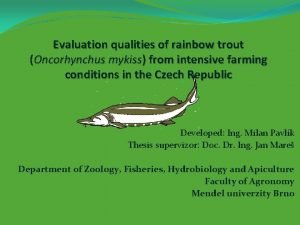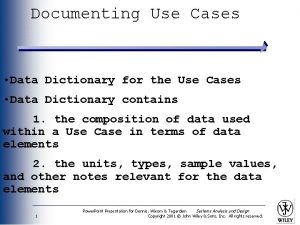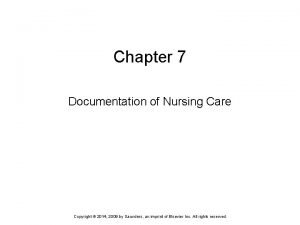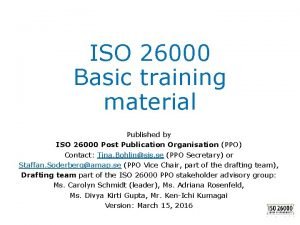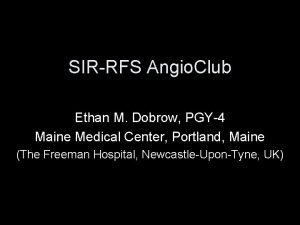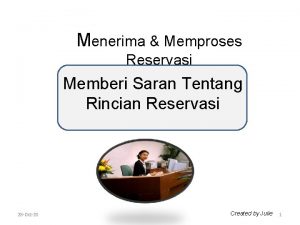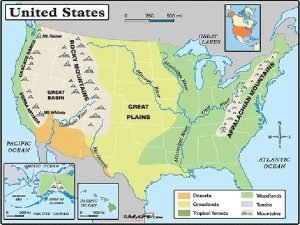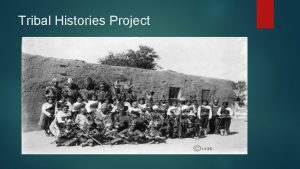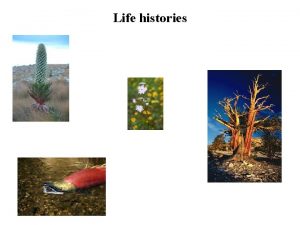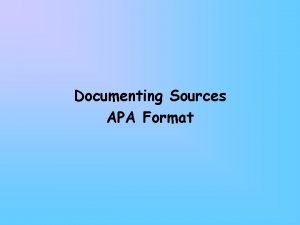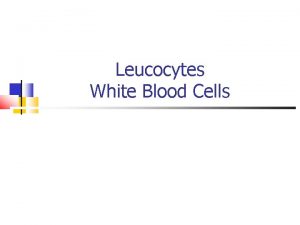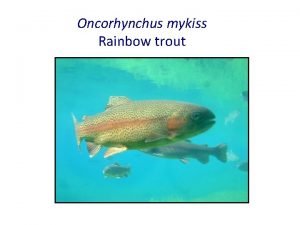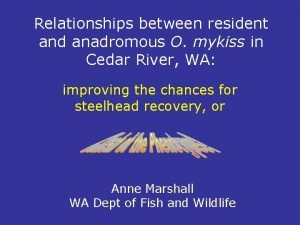Documenting O mykiss life histories in the White
























- Slides: 24

Documenting O. mykiss life histories in the White Salmon River prior to the reintroduction of anadromous fish above Condit Dam. Brady Allen and Patrick J. Connolly U. S. Geological Survey-Biological Resources Discipline Western Fisheries Research Center Columbia River Research Laboratory U. S. Department of the Interior U. S. Geological Survey

Tr ou t e. C re ek White Salmon River Buck Ck. Falls La k Big Brother Falls BZ Falls ek Husum Falls e es k na tl at R e Cr Falls Condit Dam Columbia River

Condit Dam Facts • Built in 1913 • 92 acre reservoir • 2. 4 million cubic yards (1. 8 m 3) sediment • Watershed = 390 square miles • Average flow of 1000 cfs • Draining will take 6 hrs at 11, 000 cfs (~ 100 yr flood event) • Highest flow recorded was 45, 000 cfs in 1996 • Much of the river is in a narrow basalt canyon • Once passable for fish it will open 33 miles for steelhead 14 miles for chinook

Overview § White Salmon Working Group § § § Focal species § Science guided plans Options identified Options recommended

White Salmon Working Group § An update of fish salvage and reintroduction plan was necessary § § Working group was formed and first met in February 2007 § § § Coordination of fish salvage prior to removal Information sharing and identification of reintroduction options Pre and post removal monitoring and evaluation Opportunities to work with partners on fisheries and habitat restoration in the basin

Species considered: § summer and winter § § § steelhead fall Chinook salmon spring Chinook salmon coho salmon chum salmon bull trout pacific lamprey

Options considered: 1) No action, natural colonization, re-evaluate in 5 -10 yrs 2) Salvage wild fish and outplant above Condit Dam, prior to removal 3) Salvage wild adults, spawn in hatchery, release juveniles in White Salmon River after removal 4) Use adjacent hatchery/wild stock, release juveniles/adults in White Salmon River after removal

Options recommended by the White Salmon Workgroup § Summer and winter steelhead, and spring Chinook salmon - monitor natural escapement, re-evaluate options in 5 years

Conclusions § § Options incorporated into NOAA’s Endangered Species Act recovery plans for Middle Columbia River steelhead and Lower Columbia River Chinook, coho, and chum salmon The existing datasets and findings provide some information prior to reintroduction, much more could be learned

Two types of tags for tracking fish in the White Salmon subbasin: Radio Passive Integrated Transponder (PIT) Tags & PIT Tags Radio Tags Uniquely identify individuals. Can be read from long distances. Cannot be put in small fish. Can be put in small fish. Tags are expensive. Battery life is limited. Tags are not expensive. No battery, lasts the life of the fish, or longer.

BZ Falls e. S hit W on alm er Riv ree eek r C Husum Falls eek ll C ke na s e l tt Ra Cr Mi ls Fal Lower Buck Cr. Falls ck k Northwestern Lake Condit Dam iver on R alm ite S Wh How do fish use the system? Upper Buck Cr. Falls Bu Connectivity within the White Salmon watershed _____ Columbia River

Habitat use and life history characteristics of rainbow trout in the White Salmon River above Condit Dam Objective Assess connectivity of Northwestern Lake with mainstem White Salmon River and its tributaries Funded by: Condit Dam, White Salmon River Basin (WA)

Fish collection: hook and line Data collected: location, length, weight, scale sample, and genetic sample PIT tagging surgery if radio tagged


BZ Falls Radio Tagging: § Waterfall 2001: 44 tags § § § 12 above Husum 9 below Husum 23 in reservoir Husum Falls § 2002: 20 tags § § 10 above Husum 10 below Husum Remote PIT tag interrogator Condit Dam

Conclusions: Most fish moved less than 3 km Rattlesnake and Buck creek are used as spawning tributaries Resident trout can pass above Husum Falls Behavior of trout in the White Salmon River watershed is diverse

Assess Current and Potential Salmonid Production in Rattlesnake Creek Associated with Restoration efforts Objectives 1. ) Characterize fish populations, isotopes, water quality/quantity, and habitat prior to reintroduction 2. ) Identify restoration needs Funded by: Bonneville Power Administration

Falls Fish sampled and tagged (n=4, 813) Ra Falls Condit Dam reek and. C ian Creek Indi. In Husum Falls Species, abundance, movement, growth, disease tt le iver lmon R n Sa White n Instream PIT-tag C e interrogation k a system sn k e re

Rattlesnake Creek antenna system To AC Power and Data Storage Flow Multiplexing transceiver

Falls e. S hit k e e Falls r e Riv tt le Ra 0. 7% (1, 329) 22% (1, 102) 12% (438) reek and. C ian Creek Indi. In Condit Dam r C e k a sn 0. 1% (1, 184) on alm Husum Falls How do fish use the system? 1% (289) Instream PIT-tag interrogation system W Connectivity to the White Salmon watershed _____ 21% (116) 12% (355)

Flow and downstream fish movement

East Sand Island 27 Oct 2004: Tagged at 156 mm in lower Rattlesnake Creek 27 April 2005: Detected leaving Rattlesnake Creek 15 Nov 2005: Tag found at East Sand Island Caspian tern colony Bonneville Dam 16 Sept 2004: Tagged at 98 mm in Indian Creek (tributary) 29 March 2005: Detected leaving Rattlesnake Creek 22 July 2006: Detected moving up through Bonneville adult fish ladder as a onesalt summer steelhead Bonneville Dam

Summary of findings Fish Behavior in Rattlesnake Creek: • Husum Falls was not a barrier to larger resident trout • Little connection between trout above and below lower Rattlesnake Creek waterfall at RKM 2. 4 • Spawning resident trout from the White Salmon River use Rattlesnake and Buck creeks • Some White Salmon trout over-winter in Rattlesnake Creek • Many Rattlesnake and Indian creek trout emigrate to the White Salmon River, during spring, smolt like – some continue to express anadromy

Now. Future?
 Oncorhynchus mykiss
Oncorhynchus mykiss Anatomy of trout
Anatomy of trout Doing life histories and biographical research ppt
Doing life histories and biographical research ppt Documenting use cases
Documenting use cases Fdar charting
Fdar charting Understanding and documenting iso 26000 training
Understanding and documenting iso 26000 training Week by week plans for documenting children's development
Week by week plans for documenting children's development Documenting maine jewry
Documenting maine jewry Documenting java code
Documenting java code Seven parts of the patient history form
Seven parts of the patient history form Reservation histories adalah
Reservation histories adalah Charles dickens song horrible histories
Charles dickens song horrible histories What is the first permanent english settlement
What is the first permanent english settlement North america, family histories, 1500-2000
North america, family histories, 1500-2000 White sheep white sheep on a blue hill meaning
White sheep white sheep on a blue hill meaning Ellen g white biography
Ellen g white biography Hát kết hợp bộ gõ cơ thể
Hát kết hợp bộ gõ cơ thể Slidetodoc
Slidetodoc Bổ thể
Bổ thể Tỉ lệ cơ thể trẻ em
Tỉ lệ cơ thể trẻ em Gấu đi như thế nào
Gấu đi như thế nào Thang điểm glasgow
Thang điểm glasgow Hát lên người ơi alleluia
Hát lên người ơi alleluia Môn thể thao bắt đầu bằng từ chạy
Môn thể thao bắt đầu bằng từ chạy Thế nào là hệ số cao nhất
Thế nào là hệ số cao nhất
